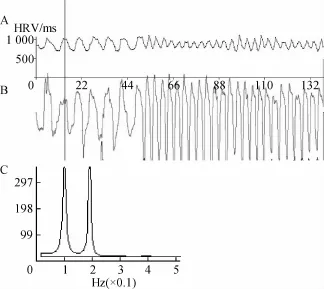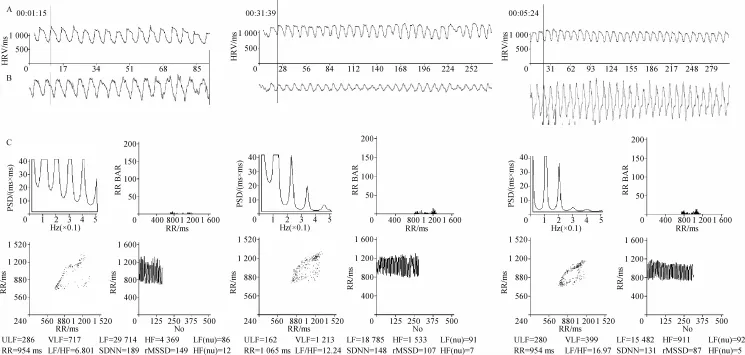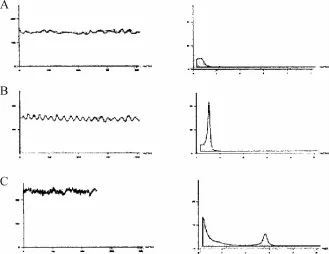Factors influencing the use of heart rate variability for evaluating autonom ic nervous function in m ind-body research
2017-04-17
Factors influencing the use of heart rate variability for evaluating autonom ic nervous function in m ind-body research
Shin LinZhong-Yuan ShenTimothy Ross
Heart rate variability(HRV)analysis is a common method to non-invasively evaluate autonomic nervous function.In many studies,low frequency variability(LF,<0.15 Hz as shown in the power spectrum produced by Fast Fourier Transformation)is taken as an indicator of sympathetic function and high frequency variability(HF,≥0.15 Hz)as an indicator of parasympathetic function.Based on studies on over 20 control subjects and 15 mind/body practitioners,we found that the following are important factors that influence HRV.First,the frequency of the breathing cycle is reflected in the frequency of a peak in the power spectrum produced by respiratory sinus arrhythmia(RSA).In some cases involving younger subjects,multiple peaks can be seen in the power spectrum even though they were strictly controlling their breathing at a single rate.Second,the size of the HRV peak produced by RSA is dependent on the tidal volume of each breath and the posture of the subject.Third,under the same conditions,younger subjects(aging20's-25's)generally show a larger RSA peak compared to older subjects(aging 50's-70's).This effect often overshadows differences based on other considerations,such as years of experience in mind-body practice.In conclusion,this study shows that HRV analysis can be a useful tool for assessing autonomic nervous function inmind-body research,butgreat caremustbe taken to control for all of the factors indicated above.
heart rate variability;respiratory sinus arrhythmia;autonomic nervous function;mind-body research
Mental stress is recognized as a major threat to health and well-being because this type of psychosocial condition can lead directly or indirectly tomany illnesses,from the common cold to heart disease and cancer[1-3].Mind-body practices such as Tai Chi,Yoga,and various types of stationarymeditation are important interventions in the rapidly growing field of Integrative Health and Medicine because of mounting evidences that they are effective in relieving stress[4-6].A common feature among these practices is the coordinated regulation ofmind,body and respiration.Therefore,to understand the mechanisms by which these practices exert their stress relieving benefits,one important experimental approach is to quantify how these regula-tions can separately and collectively affect the sympathetic and the parasympathetic branches of the autonomic nervous system.
Heart rate variability(HRV)analysis of electrocardiogram(ECG)has long been used as a non-invasive method to evaluate autonomic nervous function[7-11].In this type of methodology,low frequency variability[LF,<0.15 Hz as shown in the power spectrum produced by Fast Fourier Transformation(FFT)]is taken as an indicator of the level of sympathetic function and high frequency variability(HF,≥0.15 Hz)as an indicator of the level of parasympathetic function.However,great care has to accompany the interpretation of HRV data using the LF and HF indexes because many physiological factors such as heart rate and respiratory rate are known to affect the R-R interval recorded in the ECG[12-14].In our Laboratory forMind-Body Signaling and Energy Research at the University of California,Irvine,and the Shanghai Qigong Research Institute,our interests are focused on those physiological factors that aremost relevant to studies on mind-body practices.In the following Results section,we present representative graphs from many that we have collected to illustrate why such factors should be taken into consideration in mind-body research.
1 Materials and methods
1.1 Instrum entation
Custom made Holter-type monitors(from PI Instruments,Shanghai)with the capability of simultaneously recording ECG and respiratory patterns(measured via upper body straps with stretch transducers) were used in this study.Data collected were downloaded onto a computer with software that displayed the raw data as ECG and analyzed data as time series and FFT power spectrum.
Tidal volume was measured with an electronic as well as a mechanical spirometer.
1.2 Human subjects
Fifteen experienced mind/body practitioners and 20 individuals with no experience,males and females ranging in age from 20 to 70 years old,participated in the study.They provided informed consent in accord with a protocol approved by the Institutional Review Board of the University of California,Irvine.
2 Resu lts
2.1 Frequency of FFT spectral peak linked to breathing rate
Fig.1 illustrates the phenomenon that breathing at a specific rate produces a distinct peak at the corresponding frequency in the FFT power spectrum.Hence,a subjectwho breathed at 6,12,or 24 cycles per minute generated peaks at 0.1,0.2,or 0.4 Hz,respectively.Additionally,two distinct frequency matched peaks were generated in the spectrum when a subject breathed at one rate,and then changed to a higher rate within the period of analysis(Fig.2).The above observations linking the rates of lung and heart functions are referred to as respiratory sinus arrhythmia(RSA)[15].In this study,we found that the size of the RSA peaks is generally larger with younger subjects(aging 20's25's)compared to those of older subjects(aging 50'70's)under the same respiratory conditions.

Fig.1 Respiration-dependent peak in HRV power spectra at different breathing rates

Fig.2 HRV at two breathing rates during a single measurement period
2.2 Mu ltip le FFT spectral peaks at a single respiratory frequency
With some but not all of the younger subjects we have tested,breathing ata single rate during the analysis period consistently produced more than one peak in the FFT power spectrum(Fig.3).There would be a large peak corresponding to the breathing rate,butadditional peaks of decreasing magnitude could also be seen.The size of these peaks was dependent on the tidal volume of the breath(Fig.4);this dependency of peak size on tidal volume has also been seen with subjects who generated a single peak in the spectrum while breathing at a single rate.The multiple peaks had not been seen with any of the older subjects we have tested,but there were insufficient experiments conducted to reach a definite conclusion on this point.Whether this phenomenon ofmultiple peaks has a physiological basis or is the result of the analytical protocol remains to be further investigated.

Fig.3 Multip le RSA peaks at a single b reathing rate
2.3 Posture affects the size of RSA peaks
Tidal volume is not the only parameter affecting the size of RSA peaks.In an experiment shown in Fig.5,the size of the RSA peak was the biggestwhen the subjectwas in a supine position,smallerwhen sitting,and the smallestwhen standing.
2.4 Appearance of high frequency peak in FFT spectrum during m editation
Some of the highly experienced mind-body practitionerswe have tested can generate a single high frequency peak of around 0.3 Hz in FFT power spectrum while breathing at a slow rate duringmeditation(Fig.6).This type of HF peak could reflect a genuine increase in the level of parasympathetic function when the subject is in a state of deep relaxation and rest[7-10].In fact,some highly experienced meditators have been seen tomaintain such a HF peak before and after the meditation period,possibly due to having a psychophysiological state that is generally calmer at baseline compared to inexperienced subjects.

Fig.4 HRV power spectra at different tidal volumes

Fig.5 HRV power spectra at differen t postures

Fig.6 Time series(left panels)and corresponding power spectra(right panels)for amale subject(60 years old)recorded at rest(A),during breathing regulation(B),and during meditation(C)
3 Discussion
3.1 Mechanism s underlying RSA
The rhythmic fluctuations of electrocardiographic R-R intervals coupled to respiratory inhalationexhalation cycles,referred to as RSA,is thought to be mediated by the autonomic nervous system[15].However,itshould also be noted thatothermechanismsmight also be involved.For instance,we have previously observed that blockage of autonomic function by a pharmacological inhibitor or by severance of a relevant nerve in animals did not eliminate coordination of respiratory rate and heart rate[16].The reason behind these results requires further investigation.
3.2 Clinical app lications of HRV
HRV analysis is used extensively in clinical settings for evaluation of the balance between sympathetic and parasympathetic branches of the autonomic nervous system.Onemajor area of such applications is related to heart function.For instance,it is known that low HRV is associated with increased risk for coronary heart disease[17],and patients with chronic heart failure show impaired HRV at rest and during deep breathingmaneuver[18].
An associated area of application is related to lung function.HRV has been shown to be a useful parameter in decidingwhen towean patients from mechanical ventilation[19].It also has potential as a tool for evaluating aerobic capacity[20]and respiratory muscle strength[21]in patients with chronic obstructive pulmonary disease(COPD).
A third area of application is in sleep research.HRV indexes have been demonstrated to change with different stages of sleep[22-23],and changes in some of these parameters have been recorded in patients with sleep related breathing disorders[24-25].
3.3 HRV for m ind-body research
Mind-body practices can generally be divided intotwo categories.The first category is stationarymeditation,in which the subject remains non-moving in a sitting or standing position.Examples are Zen meditation,transcendental meditation,and the“standing post”meditation practices included in somemartial art and Qigong styles.The second category ismovingmeditation,in which the subject ismoving either in a repetitive or variable sequence ofmotion.Examples are Tai Chi and Yoga.One common feature among these diverse stylesofmind-body practices is thatalmosteveryone emphasizes slow and deep cycles of breathing.
In an early study on Zen meditation,practicing with sustained attention in the sitting position accompanied by breath control,the researchers compared HRV and theta wave rhythm in electroencephalography(EEG)recorded at the frontalmidline area as an indicator of a state of relaxation[26].They concluded from their analysis of HRV data using a geometric,nonspectralmethod[27]that the increase in power of theta waves during a state of relaxed concentration is accompanied by depression of their index for sympathetic function compared to data from control subjects.However,they did not find any correlation between theta waves and their index for parasympathetic function.In another study from the same era,researchers used HRV to study a traditional form of Chi(Qigong)meditation and Kundalini Yoga,both being practiced in the sitting position[28].They reported that there was a strong HF peak corresponding to the breathing rate during both types ofmeditation by experienced practitioners.Themagnitude of the peak was greater than that of those seen prior to the meditation period,and the peaks generated by meditation-naive control subjects with breathing rate guided by ametronome.
HRV was also used in several studies on TaiChi,often referred to as"meditation in motion".Conclusions from those studies are summarized in a recent review[29].Overall,there seems to be an association between enhancement of HRV and Tai Chi practice,but a firm conclusion awaits a greater number of studies of larger sample size to be conducted in the future.
3.4 Practical app lications of HRV in m indbody practices
Those who are interested in mind-body practices for health and healing often have the following questions:(ⅰ)How can the efficacy of different types of practices be compared?(ⅱ)How can the progress in training be quantitatively gauged?(ⅲ)How can qualifications and accomplishments of teachers and students be objectively determined?Since amain purpose of all mind-body practices is to induce a calm and relaxed mental state,it can be expected that HRV would be useful for answering these practical questions.However,the findings presented here show that a number of confounding factors should be taken into consideration when attempting to apply HRV to such practical applications.
Most importantly,as being illustrated here and in other reports[12,13,28],peaks in FFT power spectrum can be generated by controlled breathing at a corresponding rate independent of the state of stress or relaxation.Therefore,at the slow breathing rate of around 4-6 cycles perminute which are common during many mind-body practices,there will be an RSA peak within the LF region of the FFT power spectrum.Contrary to the common interpretation of HRV[10],this LF peak does not necessarily indicate elevation of sympathetic tone.A similar problem occurs when LF/HF is used as an index for sympathetic versus parasympathetic balance[29].Thus slow breathing during meditative practices can lead to a high value for LF and LF/HF that might mistakenly lead to the conclusion that the subject is in a stressful state.Conversely,if the subject breathes at a higher rate(e.g.,12 cycles per minute),therewill be an RSA peak in the HF region,which might mistakenly be interpreted as an evidence for a desirable state of relaxation.In addition to the effect of breathing rate on RSA,we previously reported that respiratory cycles also cause simultaneous fluctuations of blood pressure[30].These changes might also complicate evaluation of the tested subject's state of stress or relaxation.Therefore,test subjectsmustbreath at the same rate to allow direct comparison of their HRV data.
Second,we showed here that the magnitude of a RSA peak recorded ata given breathing rate is dependent on the posture of the subject.This phenomenon makes it difficult to directly compare HRV peaks recorded from subjects during the performance of sitting versus standing meditation.Comparison of HRV peaksfrom subjects performing Tai Chi and Yoga is even more problematic because of the constant change in posture during these practices.
The third consideration involves the potential use of HRV to evaluate the level of accomplishment of mind-body practitioners.In one report,experienced practitioners seem to have RSA peaks that are greater inmagnitude than control subjects breathing at a regulated rate[28].We also showed here that an experienced meditator can generate an HF peak unrelated to RSA.On the other hand,we also showed here that tidal volume and the age of the subject influence the size of the RSA peak.These two observations can confound comparison made between practitioners of different ages,years of experience and lung capacity.For instance,more accomplished practitioners tend to be older and the age factor would make their HRV peaks lower than less accomplished but younger practitioners.
In conclusion,peaks caused by RSA are major contributors to the HRV power spectrum.The magnitude of these peaks is dependent on tidal volume,posture,and the age of the test subject.These peaksmust be taken into account when indexes such as LF and LF/HF as indicators of sympathetic and parasympathetic balance were used during mind-body practices.
Acknow ledgements
Thiswork was supported in part by the Lawrence S.Rockefeller Fund/Samueli Program for Energy Medicine Research and the Joseph and Sou-Lin Lee Endowment for Traditional Chinese Medicine Research.
[1]Cohen S,Tyrrell DA,Smith AP.Psychological stress and susceptibility to the common cold[J].N Engl J Med,1991,325(9):606-612.
[2]Chida Y,Hamer M,Wardle J,et al.Do stress-related psychosocial factors contribute to cancer incidence and survival?[J].Nat Clin Pract Oncol,2008,5(8):466-475.
[3]Greenwood DC,Muir KR,Packham CJ,et al.Coronary heart disease:a review of the role of psychosocial stress and social support[J].J Public Health Med,1996,18(2):221-231.
[4]Wang F,Lee EK,Wu T,et al.The effects of tai chi on depression,anxiety,and psychological well-being:a systematic review and meta-analysis[J].Int J Behav Med, 2014,21(4):605-617.
[5]van der Kolk BA,Stone L,West J,et al.Yoga as an adjunctive treatment for posttraumatic stress disorder:a randomized controlled trial[J].J Clin Psychiatry,2014,75(6):e559-565.
[6]Chen KW,Berger CC,Manheimer E,et al.Meditative therapies for reducing anxiety:a systematic review and meta-analysis of randomized controlled trials[J].Depress Anxiety,2012,29(7):545-562.
[7]Akselrod S,Gordon D,Ubel FA,et al.Power spectrum analysis of heart rate fluctuations:a quantitative probe of beat-to-beat cardiovascular control[J].Science,1981,213(4504):220-222.
[8]Pomeranz B,Macaulay RJ,CaudillMA,etal.Assessment of autonomic function in humansby heart rate spectralanalysis[J].Am JPhysiol,1985,248(1 Pt2):H151-153.
[9]Saul JP.Beat-to-beat variations of heart rate reflectmodulation of cardiac autonomic outflow[J].Physiology,1990,5(2):32-37.
[10]Task Force of the European Society of Cardiology,the North American Society of Pacing and Electrophysiology.Heart rate variability:standards ofmeasurement,physiological interpretation,and clinical Use[J].Circulation,1996,93(5):1043-1065.
[11]XWarren JH,Jaffe RS,Wraa CE,et al.Effect of autonomic blockade on power spectrum of heart rate variability during exercise[J].Am J Physiol,1997,273(2):R495-R502.
[12]Shen ZY,Lin S,Yu P,etal.The influence of respiratory frequency adjustment to heart rate variability[J].JPractical Electrocardiology,2009,18(5):323-325.
[13]Shen ZY,Liu RG,Lin S,et al.Relationship between cycle andmorphological characteristics of nighttime respiratorymethod and heart rate variability[J].J Practical Electrocardiology,2012,21(3):157-161.
[14]Gasior JS,Sacha J,JeleńPJ,et al.Heart rate and respiratory rate influence on heart rate variability repeatability:effects of the correction for the prevailing heart rate[J].Front Physiol,2016,7:356.
[15]Eckberg DL.The human respiratory gate[J].JPhysiol,2003,548(Pt2):339-352.
[16]Zhu YQ,Shen ZY,Lin S,etal.The influenceof autonomic nerve block on rabbits'heart rate under respiratory regulation[J].JPractical Electrocardiology,2014,23(6):405-410.
[17]Dekker JM,Crow RS,Folsom AR,et al.Low heart rate variability in a2-minute rhythm strip predicts risk of coronary heart disease and mortality from several causes:the ARIC Study[J].Circulation,2000,102(11):1239-1244.
[18]Reis MS,Arena R,Archiza B,et al.Deep breathing heart rate variability is associated with inspiratory muscle weakness in chronic heart failure[J].Physiother Res Int,2014,19(1):16-24.
[19]Arcentales A,Caminal P,Diaaz I,etal.Classification of patients undergoing weaning from mechanical ventilation using the coherence between heart rate variability and respiratory flow signal[J].Physiol Meas,2015,36(7):1439-1452.
[20]Leite MR,Ramos EM,Kalva-Filho CA,et al.Correlation between heart rate variability indexes and aerobic physiological variable in patientswith COPD[J].Respirology,2015,20(2):273-278.
[21]Goulart Cda L,Simon JC,Schneiders Pde B,et al.Respiratory muscle strength effect on linear and nonlinear heart rate variability parameters in COPD patients[J].Int JChron Obstruct Pulmon Dis,2016,11:1671-1677.
[22]Villa MP,CalcagniniG,Pagani J,et al.Effects of sleep stage and age on short-term heart rate variability during sleep in healthy infants and children[J].Chest,2000,117(2):460-466.
[23]Togo F,Yamanoto Y.Decreased fractal component of human heart rate variability during non-REMsleep[J].Am JPhysiol Heart Circ Physiol,2001,280(1):H17-H21.
[24]Clifford GD,Tarassenko L.Segmenting cardiac-related data using sleep stages increases separation between normal subjects and apnoeic patients[J].Physiol Meas,2004,25(6):N27-N35.
[25]Aeschbacher S,Bossard M,Schoen T,et al.Heart rate variability and sleep-related breathing disorders in the general population[J].Am JCardiol,2016,118(6):912-917.
[26]Kubota Y,SataW,ToichiM,et al.Frontalmidline theta rhythm is correlated with cardiac autonomic activities during the performance of an attention demanding meditation procedure[J].Brain Res Cogn Brain Res,2001,11(2):281-287.
[27]ToichiM,Sugiura T,Murai T,etal.A newmethod of assessing cardiac autonomic function and its comparison with spectral analysis and coefficient of variation of R-R inter val[J].JAuton Nerv Syst,1997,62(1-2):79-84.
[28]Peng CK,Mietus JE,Liu Y,etal.Exaggerated heart rate oscillation during two meditation techniques[J].Int J Cardiol,1999,70(2):101-107.
[29]Cole AR,Wijarnpreecha K,Chattipakorn SC,etal.Effects of Tai Chi exercise on heart rate variability[J].Complement Ther Clin Pract,2016,23:59-63.
[30]Shen ZY,Lin S,Yan SB,et al.Relationship between blood pressure instant variability and heart rate variability of rabbits under respiratory control[J].Shanghai JTradit Chin Med,2013,47(3):72-75.
Shin Lin,男,细胞生物学、生物医学工程学、综合医学教授,美国著名生物物理学家。1965年毕业于加州大学戴维斯分校,化学学士;1967年毕业于加州大学圣地亚哥分校,化学硕士;1971年毕业于加州大学洛杉矶分校,生物化学博士;1974年毕业于加州大学旧金山分校,生物化学及生物物理学院博士后。1974至1997年任美国霍普金斯大学教授、生物物理系主任、科学学院副院长。1997至2002年任美国加州大学尔湾分校副校长兼生物科学院院长,继续从事细胞生物学领域的研究。2003后在美国加州大学尔湾生物科学院细胞生物学系、生物医学工程系、生物物理中心、Susan Samueli医学发展基金中心从事身心医学及心理生理生物学方向的基础研究。
Shin Lin教授长期从事应用生物化学、生物物理学、分子生物学和分子生物物理学及细胞动力学的研究。他的主要研究方向:影响肌动蛋白细胞骨架和能动功能的自然产物(如松胞菌素)的活动的构造;对调节组合肌动蛋白进入大细胞的细胞骨架结构的细胞蛋白的定义、提取及特性记述;正常细胞的扩散及移动中导致细胞骨架结构的变更的信号通路;改变细胞骨架蛋白的信号、结构及活性、oncognenic变形。
Shin Lin教授曾获得美国国家卫生研究院研究发展奖,美国心脏研究协会委员会临床科学家奖。曾任美国国家科学进步委员会委员,美国国家卫生部和美国国立卫生研究院(NIH)替代和补充医学咨询委员,《McGraw Hill科技百科全书》生物物理学顾问主编,《受体研究杂志》(Journal of Receptor Research)编委会副主编,在美华人生物物理学家协会主席等,并在国际权威专业杂志上发表过70多篇论文。
Fund Program:the Lawrence S.Rockefeller Fund/Samueli Program for Energy Medicine Research;the Joseph and Sou-Lin Lee Endowment for Traditional Chinese Medicine Research
Author Unit:92697 Irvine,California,USA,Department of Biophysical Research Center,University of California,Irvine(Shin Lin,Timothy Ross);200030 Shanghai,China,Qigong Research Institute,ShanghaiUniversity of Traditional Chinese Medicine(Zhong-Yuan Shen);98195 Seattle,Washington,USA,Project Department,Building Research Across Inter-Disciplinary Gaps(BRIDG)Program,University ofWashington(Timothy Ross)
Author Brief Introduction:Shin Lin,Professor,famous American physicist;research interests:application of biochemistry,biophysics,molecular biology and molecular biophysics,and cell dynamics research,E-mail:shinlin@uci.edu
